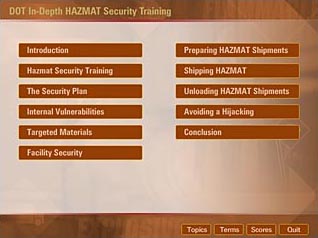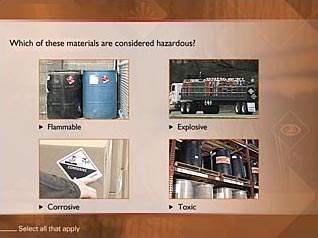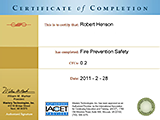Back to Course List
DOT: HAZMAT: In-Depth HAZMAT Security Training

- Product ID
- smaxdidt
- Training Time ?
- 51 to 102 minutes
- Language(s)
- English
- Video Format
- Standard Definition
- Required Plugins
- MasteryNet Player
- Lesson Interactions
- 18
- Quiz Questions
- 32
- Closed Captioning



Overview
DOT Hazmat Security Compliance Training
In this indepth DOT security training workers will learn why security is necessary. They will learn about the facilities security plan and how to protect against security breaches. After completion, workers will have a thorough understanding of hazmat security and know how to provide a secure DOT shipment. Workers will learn about inspections, proper unloading procedures, in-route safety measures and steps to avoid hijackers.
![]() This course is in the Advantage™ format, to read about Advantage™ features click here.
This course is in the Advantage™ format, to read about Advantage™ features click here.
- Rich multimedia presentation with interactions and quiz
- Print certificate and wallet card
- You have 30 days to complete the course
- CEUs awarded
Workplaces
Audience
All workers involved in the shipment of hazardous materials.
Topics
The course presents the following topical areas:
-
Why Security?
- Why Security is Necessary
-
HAZMAT Security Training
- Security Training
-
The Security Plan
- The Security Plan Written Requirement
- Security Plan Training
-
Internal Vulnerabilities
- The Security Vulnerability Analysis
- Measures to Prevent Security Breaches
- Unintentional Security Breaches
-
Targeted Materials
- The DOT Emergency Response Guidebook
- Analyzing Security Measures
-
Facility Security
- Securing the Facility
- Delivery Security
- High-Risk Facility Security
-
Preparing HAZMAT Shipments
- The Crisis Communication System
- Security for Shipping Preparations
-
Shiping HAZMAT
- Methods of Transportation
- The Pre-Trip Inspection
- In-Route Safety Measures
- In-Route Communication
-
Unloading HAZMAT Shipments
- Unloading Hazardous Shipments
-
Avoiding a Highjacking
- Steps to Avoid Hijackers
- If You Are Being Followed
Intended Performance Outcomes
Upon successful completion of this course you will be better prepared to:
-
Comply with DOT training requirements for all HAZMAT employees.
- Recall portions of the In-Depth Security Training program.
- Agree that employees can be the first line of defense against terrorism.
-
Follow your facility written security plan.
- Identify hazardous materials requiring a written security plan.
- List items in the security plan that require training.
- Agree that it is the responsibility of every employee to follow security measures.
- Choose reasons to keep your company Security Plan confidential.
-
Identify facility vulnerabilities and ways to address them.
- Agree that the first step in creating a security plan is to perform a Security Vulnerability Analysis.
- List methods and procedures used to make a facility more physically secure.
- Agree to refrain from public discussions about hazardous materials handled at your facility.
-
Recognize materials that might be targeted for terrorism.
- State the second step in performing a Security Vulnerability Analysis.
- Agree to include hazardous material quantities and physical state in the Security Vulnerability Analysis.
- Select the DOT Emergency Response Guide Book as a resource to determine hazardous material characteristics and hazards.
- List the next step to take once hazardous materials have been identified.
-
Maintain security within your facility.
- List methods and items to prevent unauthorized facility access.
- Choose the best way to secure access to a facility.
- List steps to take before allowing a delivery vehicle on facility grounds.
- Identify security measures for High Risk facilities.
- Agree to conduct regular inventories of hazardous materials to determine if there are any shortages.
-
Properly prepare hazardous materials for shipping.
- Define the purpose of a Crisis Communication System.
- Agree to ship hazardous materials in smaller quantities whenever possible.
- Identify suspicious activities when taking orders for Hazardous Materials.
-
Safely ship hazardous materials.
- Recall the most widely used form of transportation used to ship hazardous materials.
- Agree to perform a pre-trip inspection prior to leaving a facility.
- List safety measures when shipping hazardous materials.
- Identify unsafe methods of communication when shipping hazardous materials.
-
Follow proper procedures for unloading hazardous material shipments.
- Agree to always check shipping papers.
- List suspicious things to look for when receiving hazardous materials.
- Agree to refuse any damaged container.
- Recall the need to close warehouse doors immediately after a shipment has been unloaded.
-
Take steps to avoid possible hijacking attempts.
- Identify actions that discourage hijacking.
- Recall steps to take if you suspect a hijacking attempt.
© Mastery Technologies, Inc.




